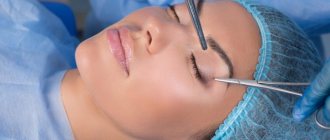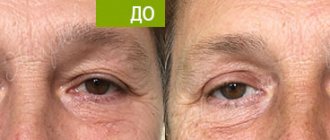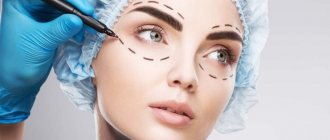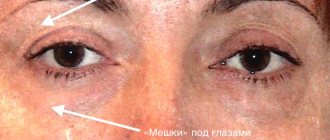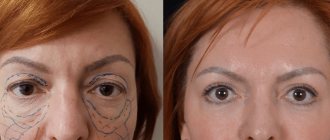Blepharoplasty is a plastic surgery to correct the shape of the eyes, lower and upper eyelids. Manipulation according to statistics is most often used by people over 35 years of age who would like to eliminate age-related changes or by patients who have congenital and acquired defects in appearance.
There are several types of surgery. The most commonly performed procedures are: upper, lower and circular blepharoplasty, canthopexy. Less often - Singapore. Manipulation is carried out in several ways: using a scalpel, laser, endoscope. Transconjunctival blepharoplasty is also performed, in which the skin is not damaged.
PREPARATION FOR BLEPHAROPLASTY
After setting the date for the operation, the patient needs to reconsider his lifestyle, give up some “bad habits,” visit a number of specialists and make sure there are no contraindications. Here is a list of some recommendations that must be followed:
- A couple of months before blepharoplasty, avoid intense tanning.
- Be sure to visit an ophthalmologist.
- Stop smoking and alcohol (at least 2 weeks before the intervention). Nicotine and alcohol impair blood circulation and the healing process in general.
You can find out more about how to prepare for surgery in the recommendations section.
Who needs blepharoplasty?
The procedure is recommended for patients with the following problems:
- Age-related hernias, deep wrinkles.
- Excess skin that hangs over the eyelashes makes the face appear older.
- “Bags” (overhang of infraorbital fat).
- Drooping of the outer corner of the eye.
- Large folds in the corners of the eyes, on the eyelids.
The operation is also indicated for patients who want to correct the shape of the eyelid or the shape of the eyes. It is usually performed on adults - 40 years and older.
TYPES OF BLEPHAROPLASTY: UPPER, LOWER, CIRCULAR, TRANSCONJUNCTIVAL
An eyelid lift is performed under local or general anesthesia. The duration of the operation is from 30 minutes to 2 hours (in combination with a facelift).
- Upper blepharoplasty involves removing excess skin and fatty hernia formations of the upper eyelid,
- Lower blepharoplasty allows you to eliminate fat bags under the eyes and straighten the skin of the lower orbital zone. The incision is made along the ciliary edge of the lower eyelid and is practically invisible.
- Circumferential blepharoplasty simultaneously corrects the upper and lower eyelids. The incision is made along the ciliary edge of the lower eyelid and is practically invisible.
- Transconjunctival blepharoplasty is used to remove fatty hernias through a conjunctival incision on the inside of the lower eyelid. In this case, there are no external signs of surgical intervention at all.
After correction of the upper or lower eyelids, the patient can go home within a few hours. With extensive circumferential blepharoplasty in combination with lifting, the patient spends a day in the clinic. The stitches are removed after 4-6 days. The result can be fully assessed in 2-3 months.
Indications
Indications for surgery are the following disadvantages:
- the appearance of a nasolacrimal groove;
- drooping upper eyelid;
- lower eyelid hernia;
- fat deposits in the periorbital area;
- laxity in the periorbital region;
- wrinkles in the eye area;
- drooping eyebrows;
- asymmetry and birth defects;
- skin injuries in the area around the eyes;
- eversion of the eyelid;
- exophthalmos (protrusion of one or both eyes).
Surgical intervention is also used to change the shape of the eyes if it negatively affects vision or simply does not suit the person.
FEATURES OF REHABILITATION
The rehabilitation period after an eyelid lift is about two weeks. The patient must strictly adhere to certain recovery rules:
- For the first few days, strain your eyes as little as possible: stop watching TV and reading.
- Sleep on a high pillow.
- Use eye drops as prescribed by your doctor.
- Avoid heavy physical activity; you can resume sports after 3-4 weeks.
- Don't wear contact lenses for two weeks.
- Do not visit the sauna or swimming pool for several months, and avoid direct sunlight.
- Makeup can be applied after 10 days.
- It is better to carry out laser vision correction 6 months before or after eyelid surgery.
The effect after eyelid surgery is long lasting - more than 10 years!
Rehabilitation
After the procedure, it is recommended to do the following:
- Stay in bed for 1 hour.
- Apply cold to the operated area, use a special gel. In the first days after the intervention, you will notice slight swelling and bruising - they disappear within 7–10 days. Cold and gels will speed up the process. There may also be a feeling that the skin around the eye is tense - this is temporary, there is no need to be afraid.
- Wear sunglasses when going outside.
- Avoid using cosmetics in the operated area for several weeks.
- Avoid hot showers and strenuous physical activity for a month.
CONTRAINDICATIONS
- Acute and chronic diseases of the eyelids, dry eye syndrome
- High intraocular pressure
- Diabetes mellitus in the stage of decompensation
- Impaired function of the cardiovascular system, kidneys
EYELIDPLASTY
| NAME | Price, white rubles |
| Upper eyelid blepharoplasty | 2000 |
| Classic lower eyelid blepharoplasty | 2500 |
| Transconjunctival blepharoplasty with partial removal and redistribution of fat | from 2500 |
| Lower blepharoplasty with fat redistribution and myopexy | 3500 |
| Blepharoplasty of the upper and lower eyelids | 3500 |
Vladimir Aleksandrovich Kosinets conducts consultations in Minsk and Vitebsk. You can make an appointment by phone +375 25 902 19 44.
Eyelid surgery - blepharoplasty
Description
- an operation in which the skin hanging over the upper eyelids and “bags” under the eyes are removed
.
As you age, your eyelids stretch and the muscles that support them weaken. As a result, excess fat can collect at the top and bottom of the eyelid, causing sagging eyebrows, upper eyelids and bags under the eyes. In addition to making you look older, severe sagging skin around the eyes can reduce side (peripheral) vision, and especially the upper and outer parts of the visual field. Blepharoplasty
can reduce or eliminate these vision problems and make your eyes look younger and more vibrant.
At our Medrekplast Center for Plastic Surgery and Cosmetology in Minsk,
blepharoplasty is usually performed on an outpatient basis.
To help decide if blepharoplasty is an option for you
, find out what you can realistically expect and what the benefits and risks of blepharoplasty are.
Indications for eyelid surgery:
- Baggy or drooping upper eyelids.
- Excess skin over the upper eyelids, which interferes with your peripheral vision.
- Lower eyelids that droop so much that a white gap is visible below the iris.
- Excess skin on the lower eyelids.
- "Bags" under the eyes.
Contraindications:
- hypertonic disease;
- thyroid diseases;
- impaired lacrimation;
Photos of patients before and after eyelid lift surgery
which were carried out at our
Center for Plastic Surgery and Cosmetology “Medrekplast” in Minsk:
Preparing for surgery
Before the operation you must:
- get a consultation with an ophthalmologist
, who, after examining and examining your eyes, should tell you whether blepharoplasty is allowed in your case - complete all prescribed examinations and tests
- talk to an anesthesiologist
- Tell your surgeon and anesthesiologist about all medications you are taking
- ask someone to drive you home after surgery
Two weeks before surgery you cannot:
- smoke
- drinking alcohol
- sunbathe, as ultraviolet radiation suppresses the immune system
- take medications that reduce blood clotting
, including aspirin
On the day of surgery:
- Three to four hours before surgery, large meals and liquids are prohibited. But this issue should be discussed with the anesthesiologist, as this directly affects the safety of pain relief.
- Do not apply creams or make-up
. It is advisable to strive for the absence of skin irritation.
How is the operation performed?
You come with ready-made tests. The administrator draws up a medical history. You fill out the necessary documents and sign consent for the operation. The administrator escorts you to the room, where you change into disposable underwear, which is required in order to enter the operating room. Then you go to the surgeon and clarify all the details with him.
This is followed by an examination by the surgeon and anesthesiologist, after which a decision is made on the possibility of performing the operation at the moment. is usually taken of your eyes and face.
.
Incision lines are drawn
on the skin with a special marker .
Depending on the planned scope of the operation and individual sensitivity, both local and general anesthesia are possible. The operation itself can be performed on an outpatient or inpatient basis.
If you have to operate on the upper and lower eyelids, start with the upper
.
During blepharoplasty, the surgeon makes incisions along the crease of the eyelids to remove loose skin and muscle and remove excess fat. Then the edges of the incision are connected with a special cosmetic suture. On the lower eyelid,
the surgeon makes an incision just below the eyelashes in the natural crease or inside the lower eyelid.
It removes or redistributes excess fat, muscle and skin laxity, and closes the incision. Blepharoplasty
usually takes less than two hours, depending on the amount and location of tissue removed.
After operation
After the operation, you will be taken to the recovery room.
, where you will be in a lying position for several hours under observation.
In this case, cooling pads are applied to the eyes. Then, if the attending physician deems it possible, you can go home
.
After surgery, you may be temporarily bothered by:
- Deterioration of vision from ointment applied to the eyes
- Watery eyes
- Sensitivity to light
- Ghosting
- Redness
- Puffiness and numbness of the eyelids
- Swelling and bruising that goes away fairly quickly. On the 3-4th day the bruises turn yellow, and after 2 weeks they completely disappear
- Pain
What to do after surgery:
- Gently clean your eyelids and apply prescribed eye drops or ointments.
- physical activity, swimming, and visiting the bathhouse
for several days . - Avoid smoking
. - Don't rub your eyes.
- If you use contact lenses
, do not wear them for about two weeks after surgery. - Wear tinted glasses
to protect your eyelids from the sun and wind. - During sleep, the position of the head
should be higher than the position of the chest for several days. - Apply cool compresses
to reduce swelling. - If necessary, visit a doctor after a few days to remove the stitches and have a follow-up examination
. - Avoid taking
aspirin, ibuprofen, naproxen, and other medications or herbal supplements that may increase bleeding for several days If necessary, use acetaminophen (Tylenol, etc.) to control pain.
Contact your doctor immediately if you experience any of the following conditions:
- Dyspnea
- Chest pain
- Unusual heartbeat
- Severe pain in the eyes
- Bleeding
- Vision problems
Complications
Possible risks and complications of eyelid lift:
- Infection and bleeding
- Dry and irritated eyes
- Difficulty closing eyes
- Noticeable scars
- Eye muscle injury
- Skin discoloration
- Need for follow-up surgery
- Temporary blurred vision or, less commonly, loss of vision
- Surgical risks, including reactions to anesthesia
During your consultation, our surgeons will tell you what surgical risks apply to you. As a result, by understanding what blepharoplasty is and weighing the benefits and risks, you will decide whether this procedure is a viable option for you. And you can be sure that the specialists of our Center for Plastic Surgery and Cosmetology “Medrekplast” in Minsk
They will approach your decision with full understanding and perform the operation at the highest professional level.
Questions and answers
What effect does blepharoplasty give?
— After high-quality blepharoplasty, the face looks younger. In addition, some patients see better due to the absence of excess skin on the eyelids that interfered with peripheral vision.
Will there be any scars?
— The advantage of blepharoplasty is that the incisions are made in the folds of the eyelids and after a while they are completely invisible. If you only need to remove fatty hernias of the lower eyelids, the surgeon makes an incision not from the skin, but from the mucous membrane. In this case, the scars are not visible at all.
Does blepharoplasty get rid of wrinkles around the eyes and dark circles under the eyes?
— Other surgeries are used to remove fine wrinkles around the eyes or sagging eyebrows. Blepharoplasty does not affect them. If the dark circles are caused by fatty hernias, then the operation can have a positive effect - the circles will not be so noticeable.
Are there complications after surgery?
— The risk of complications is negligible if blepharoplasty is performed by a qualified surgeon. All patients experience bruising and swelling, but this discomfort goes away after a few days. You may also have trouble closing your eyes. As for inflammation, suture dehiscence and bleeding, such complications are very rare.
Can I take sick leave for the postoperative period?
- No. Sick leave for aesthetic surgery is not given. Of course, you will need several days of rest, so think in advance about a convenient time for the operation.
Helpful information
The eyelids are the most sensitive area of our face. It is the skin of the eyelids that is the first to react to external and internal aggressive factors. Stress, weather disasters, internal diseases and, of course, age leave marks on the delicate eyelids in the form of superficial and deep wrinkles. The skin of the eyelids becomes dull, the look becomes “extinguished”, and the whole face looks tired and aged. Eyelid fatigue is most noticeable in people who live in big cities. The harsh ecology of megacities, the intense work rhythm, and the lack of a routine affect the appearance, especially of women, not in the best way, and the fragile tissue of the eyelids begins to react to hostile influences earlier than others.
Attempts to bring the eyelids back to life with conservative measures, in particular cosmetics, bear fruit only at a young age. After 30, and even more so, 40 years, only surgical intervention is effective, i.e. – blepharoplasty.
Operation
Pain relief for upper blepharoplasty is usually local. But in some cases, combined and even general anesthesia is possible.
Incisions are made in anatomical folds, which makes it possible to hide postoperative scars almost completely. Sutures are placed taking into account the importance of the cosmetic effect. The duration of upper blepharoplasty varies within one hour. If the operation is carried out in a complex, then its time depends on the volume of intervention.
How much does blepharoplasty cost in Minsk?
The price for blepharoplasty in Minsk depends on the location (eyelids, etc.).
We recommend that you familiarize yourself with the prices in the appropriate section and attend a free consultation in our center. photo...before and after...
Ideal age for blepharoplasty
Blepharoplasty is a plastic surgery that is best performed at the age of 35 ± 5 years. This is the time when the body is still strong enough and the regeneration processes in it are quite active for the rapid healing of sutures. But our women and men seek such intervention, as a rule, a little later. Therefore, plastic surgeons have extensive experience in performing blepharoplasty at both 50 and 70 years of age with patients in satisfactory health.
But if the problem has manifested itself, then you should not wait until it “goes away on its own.” This will not happen, and the sooner blepharoplasty is performed, the brighter the effect and the more positive the result obtained.
The need for blepharoplasty in people under 30 years of age is usually due to congenital anatomical defects, such as “swollen” eyelids.
Rehabilitation period after blepharoplasty
The operation itself lasts no more than one and a half to two hours. Approximately on the third day after the operation, the stitches can be removed; it takes about a week for the bruises to resolve. Complete healing usually takes a week to a month.
Throughout the entire rehabilitation period, it is necessary to be extremely careful in complying with all the requirements of the specialist. One of the most important requirements is the refusal of makeup and the use of contact lenses. In addition, throughout the entire rehabilitation period, sudden movements should be avoided, especially careful movements of the head.
Since blepharoplasty scars are located in the natural folds of the skin, it takes about six months for them to completely heal. However, as a result, thin cosmetic scars become almost invisible, and when using makeup they are completely invisible.
The tests for this operation are as follows:
- Complete blood count + platelets + coagulation (valid for 10 days)
- Blood type, Rh factor
- Coagulogram (valid for 10 days)
- General urine test (valid for 10 days)
- RW blood test (valid for 1 month)
- Fluorography (valid for 12 months)
- Blood test for hepatitis B, C (valid for 1 month)
- HIV test (valid for 1 month)
- ECG with interpretation (valid for 1 month)
- In the presence of chronic diseases - an extract from the outpatient card with a physician’s conclusion (valid for 14 days)
